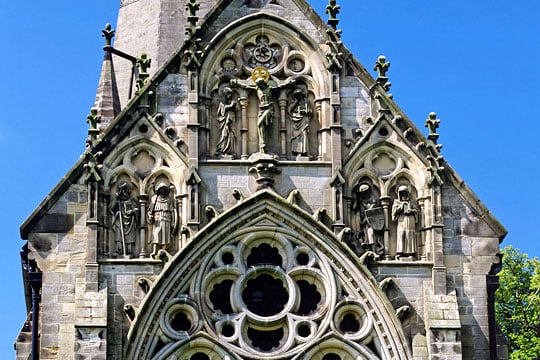Description of St Mary’s Church, Studley Royal
Prominently placed in the 18th-century landscape park at Studley Royal, St Mary’s demonstrates that for its architect, William Burges, and his Victorian patrons, modern Gothic architecture was capable of conveying complex ideas and beliefs.

Exterior
St Mary’s important secondary role as an accent in a formal, designed landscape is emphasised by its tight, symmetrical outline. The stones used for the exterior are a grey limestone from a quarry at Morcar, near Markenfield Hall, and sandstone from another local quarry, at Cat Crag, near Aldfield.
The church has a low west tower, supporting an octagonal belfry stage. This is surrounded by four pinnacled turrets that rise up to clasp a tall spire with two tiers of lucarnes (small gabled openings). Externally, decorative carving is concentrated on the east front, in which a large four-light traceried window with a rose at its apex is surmounted by three sculptural groups under gables: a Crucifixion at the top, flanked by pairs of saints, St George and St Bernard, and St Michael and St Wilfrid.
Further sculpture appears in the gable of the south porch (an Annunciation scene, proclaiming the church’s dedication to the Virgin Mary), and in the heads between the chancel windows. These heads depict human society in its various ranks and aspects: on the south, a huntsman, a male peasant, a mason, a bishop, a nobleman and a queen; and on the north, an artist or writer, a female peasant, an architect, a knight, a countess and a king.
At the west end, a low arch between the tower buttresses forms a lean-to porch sheltering the trefoil-headed west door. The window tracery becomes increasingly elaborate towards the east end, but it is given unity by being designed as a series of variations on a single motif, a lancet (narrow pointed window) with a cinquefoil head.
Interior
The church has a nave of four bays with a clerestory (an upper storey with windows) and two aisles, and a long unaisled chancel and sanctuary (the area around the altar).
The most striking aspect of the interior is the contrast between the relatively plain and monochromatic nave and the richly decorated chancel and sanctuary.
Nave
In the nave, which is furnished with fixed benches, the internal masonry is white limestone from Lord Ripon’s quarries, and the walls are finished with white plaster. The circular piers are embellished with shafts of black marble. The roof has a trefoil profile. The towering organ case, which interrupts the north nave arcade, is painted white, but was probably originally intended to be coloured. The organ is by TC Lewis of London.
The font, at the south-west corner of the nave, is made from a block of purple Tennessee marble given to Lord Ripon by an American friend. It is inset with four gilt-bronze reliefs representing the Ages of Man.
The east end of the south nave aisle is screened off to form a separate chapel, dedicated to St George. This contains the tomb of Lord and Lady Ripon, who are buried in the vault below; the tomb-chest incorporates verde antico. The sculptor of the effigies is not known.
Chancel
The extravagantly decorated chancel is influenced by 13th-century English Gothic styles and displays coloured marble, stained glass, and painted and gilded figures in all their original glory.
The chancel windows have tracery in two layers supported on shafts of black, green, red and orange marble. On the south side, the inner layer of tracery over the sedilia (seats for the clergy) is supported by a carved winged Lion of Judah.
The chancel has an arched, boarded ceiling and there is a shallow dome over the sanctuary. Both are elaborately painted and gilded, as are the upper parts of the chancel walls. The lower walls of the chancel and sanctuary are lined with purple, white and yellow alabaster, and their floors are paved with mosaic.
The bronze door decorated with a relief of the Virgin and Child that leads from the north side of the chancel to the vestry was a gift to the church from its architect.
Iconography
Almost all the decoration has iconographical significance. It makes a clear distinction between the narrative story of the Church on earth in the nave, and the depiction in the chancel and sanctuary of the New Jerusalem, which exists outside time and history.
The story of the Church begins with the west window, where the outer layer of the double tracery is carved with the stem of Jesse and the ancestors of Christ, a theme developed in the scenes from the Bible in the aisle windows. The subjects of the windows and painted decoration in the chancel and sanctuary are taken from the Book of Revelation, which culminates in a vision of the heavenly Jerusalem. This subject is emphasised by the imagery of the floor – in the chancel the principal buildings of Jerusalem, and in the sanctuary the Garden of Eden.
This celebration of the eternal paradise that awaits the faithful culminates in the depiction of the heavenly host in the domed sanctuary vault.
READ MORE ABOUT ST MARY’S CHURCH, STUDLEY ROYAL